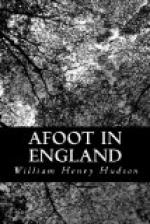The type I speak of is a very distinct one: in a crowd in a London street you can easily spot a Somerset man who has this mark on his countenance, but it shows more clearly in the woman. There are more types than one, but the variety is less than in other places; the women are more like each other, and differ more from those that are outside their borders than is the case in other English counties. A woman of this prevalent type, to be met with anywhere from Bath and Bedminster to the wilds of Exmoor, is of a good height, and has a pleasant, often a pretty face; regular features, the nose straight, rather long, with thin nostrils; eyes grey-blue; hair brown, neither dark nor light, in many cases with a sandy or sunburnt tint. Black, golden, reds, chestnuts are rarely seen. There is always colour in the skin, but not deep; as a rule it is a light tender brown with a rosy or reddish tinge. Altogether it is a winning face, with smiling eyes; there is more in it of that something we can call “refinement” than is seen in women of the same class in other counties. The expression is somewhat infantile; a young woman, even a middle-aged woman, will frequently remind you of a little girl of seven or eight summers. The innocent eyes and mobile mouth are singularly childlike. This peculiarity is the more striking when we consider the figure. This is not fully developed according to the accepted standards the hips are too small, the chest too narrow and flat, the arms too thin. True or false, the idea is formed of a woman of a childlike, affectionate nature, but lacking in passion, one to be chosen for a sister rather than a wife. Something in us—instinct or tradition—will have it that the well-developed woman is richest in the purely womanly qualities—the wifely and maternal feelings. The luxuriant types that abound most in Devonshire are not common here.
It will be understood that the women described are those that live in cottages. Here, as elsewhere, as you go higher in the social scale—further from the soil as it were—the type becomes less and less distinct. Those of the “higher class,” or “better class,” are few, and always in a sense foreigners.
Chapter Twenty-Four: Troston
I doubt if the name of this small Suffolk village, remote from towns and railroads, will have any literary associations for the reader, unless he be a person of exceptionally good memory, who has taken a special interest in the minor poets of the last century; or that it would help him if I add the names of Honington and Sapiston, two other small villages a couple of miles from Troston, with the slow sedgy Little Ouse, or a branch of it, flowing between them. Yet Honington was the birthplace of Robert Bloomfield, known as “the Suffolk poet” in the early part of the last century (although Crabbe was living then and was great, as he is becoming again after many years); while at Sapiston, the rustic village on the other side of the old stone bridge, he acquired that love of nature and intimate knowledge of farm life and work which came out later in his Farmer’s Boy. Finally, Troston, the little village in which I write, was the home of Capel Lofft, a person of importance in his day, who discovered Bloomfield, found a publisher for his poems, and boomed it with amazing success.




